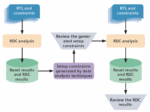The complexity of System-on-Chip (SoC) designs continues to rise at an accelerated rate, with design complexity doubling approximately every two years. This increasing complexity makes verification a more difficult and time-consuming task for design engineers. Among the key verification challenges is managing reset domain… Read More
Tag: reset domain crossing
How to Find and Fix Soft Reset Metastability
Most of us are familiar with the metastability problems that can be caused by clock domain crossings (CDC). Early static analysis techniques can flag these kinds of issues to ensure there are no surprises later. I spent quite a bit of time at Atrenta, the SpyGlass company, so I am very familiar with these challenges. Due to the demands… Read More
Automotive SoCs Need Reset Domain Crossing Checks
When the number of clock domain crossings (CDCs) in SoCs proliferated it readily became apparent that traditional verification methods were not well suited to ensuring that they were properly handled in the design. This led to the creation of new methods and tools to check for correct interfaces between domains. Now, in automotive… Read More
The Problem with Reset Domain Crossings
Design complexities in reset, like everything else in big SoC designs, has become incredibly complex, for all sorts of reasons. Long, long ago reset was something you just did once, when you turned the power on. Turn on, then hold reset for some amount of time until everything is in a known starting state, and off you go. Nice and simple.… Read More




